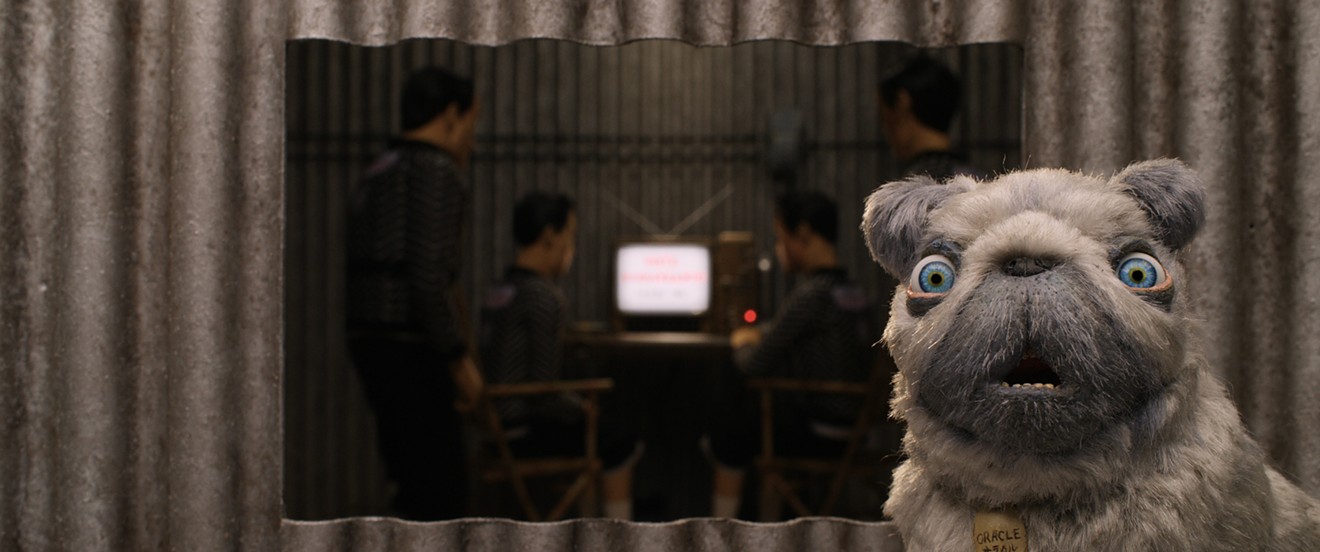If Wes Anderson finally discovered evil in The Grand Budapest Hotel, with Isle of Dogs he attempts to bring it to his level. That earlier film’s Mitteleuropean marzipan levity was haunted, and eventually consumed, by the storm of totalitarianism and murder gathering outside its impeccably curtained windows. Genocide was just over the horizon. And in Isle of Dogs, it’s here — at least metaphorically. A splendid jewel box of a movie about rather grisly matters, the filmmaker’s latest represents another example of the clash between his playfully self-aware aesthetic and his growing obsession with our inhumanity.
In the past, Anderson has seemed content to live with this sort of tension. Part of the dark charm of his work has always come from his juxtaposing cruelty with frivolity. But this time, he's also making an animated film for kids, which poses its own challenges. The director’s previous foray into the genre, the 2009 Roald Dahl adaptation Fantastic Mr. Fox, was a creepy, exciting delight — an occasionally irreverent, ultimately moving tale about responsibility and belonging. It also suggested that Anderson had an animator's heart; even many film-goers skeptical of the manicured precision of his live-action work seemed to admire the stop-motion version. The sensibility matched the form, too. Anderson's films from that period regularly centered around families, dwelling on filial bonds and intimations of mortality. That kind of intimate emotionality was perfectly in keeping with the warmhearted demands of family fare.
But in recent years, a different kind of darkness has begun to creep into his pictures — something broader, more external and uncontainable. The story of Isle takes place twenty years in the future, on the fictional Japanese island of Megasaki. That’s where gangsterish, brick-shaped Mayor Kobayashi (voiced by co-writer Kunichi Nomura), the scion of an ancient family of dog-hating noblemen who were vanquished many centuries ago, has decreed that all canines, vulnerable as they are to ailments like “dog flu” and “snout fever,” be relocated to a remote, trash-strewn atoll called Trash Island.
The tale follows a group of mismatched and exiled pups (voiced by the likes of Bill Murray, Ed Norton and Jeff Goldblum) as they attempt to aid a young boy named Atari (Koyu Rankin). He just happens to be Mayor Kobayashi's orphaned nephew and has crash-landed on the island in search of his beloved hound Spots (Liev Schreiber), the first dog exiled to this wasteland.
The particulars of their quest aren’t too dramatic, at least at first. Anderson seems more interested in elements that will add dimension to his world: a political campaign back at Megasaki drowning in criminality and corruption; an American exchange student (voiced by Greta Gerwig) who sets out to save Atari and foil Kobayashi’s evil plans; and the dogs’ own recollections of their days back in civilization — reminiscing about their favorite foods and mulling whether their attachment to humans was a good or bad thing. (A bitter but loyal former street dog named Chief, voiced by Bryan Cranston, is decidedly anti-human, and his cynicism seems to be bolstered by the humans’ actions toward the dogs.) The situation gains urgency as we learn more about what Kobayashi intends to do. And as the dogs get more desperate, the movie actually becomes funnier: Anderson has a sharp grasp of slapstick and visual humor, and he uses deadpan about as well as anybody since the great silent comedians.
But for all the laughs and the social resonance, Anderson and his team have first and foremost conjured up a work of spellbinding loveliness. This might be the director’s most visually striking film, with its luminous cityscapes, its forbidding and surreal wastelands, its smoky, shadowy interiors. He has cited Akira Kurosawa as an influence on the picture, the same way that The Grand Budapest Hotel was inspired by the work of Stefan Zweig; to that I would also add Yasujiro Ozu and Seijun Suzuki — one an artist of stillness, the other a poet of movement, both masters of color and light.
Even so, Anderson has a tough balance to strike: The humor and levity of a children's tale about dogs isn't exactly a natural match for an allegory about genocide. It’s also not the kind of metaphor you want to think about too hard. But that's partly the nature of fable, isn’t it? To touch on darker, more important themes with a certain evocative vagueness — just enough to capture the imagination without prompting us to nitpick the logic. Anderson wisely keeps his touch light throughout. There are a lot of intensely grisly directions in which this story might have gone, but the film manages to avoid them without trivializing the characters’ predicament. That is perhaps because Anderson needs to conclude things in a way that will adhere to the demands of an animated family film; he can’t leave things open-ended and dire, as he did with The Grand Budapest Hotel. To be honest, I wouldn’t be surprised if older viewers find the film’s finale a bit too quick and tidy. At the same time, I suspect Wes Anderson isn’t quite done with the problem of evil yet.
[
{
"name": "Air - MediumRectangle - Inline Content - Mobile Display Size",
"component": "12017618",
"insertPoint": "2",
"requiredCountToDisplay": "2"
},{
"name": "Editor Picks",
"component": "17242653",
"insertPoint": "4",
"requiredCountToDisplay": "1"
},{
"name": "Inline Links",
"component": "18838239",
"insertPoint": "8th",
"startingPoint": 8,
"requiredCountToDisplay": "7",
"maxInsertions": 25
},{
"name": "Air - MediumRectangle - Combo - Inline Content",
"component": "17261320",
"insertPoint": "8th",
"startingPoint": 8,
"requiredCountToDisplay": "7",
"maxInsertions": 25
},{
"name": "Inline Links",
"component": "18838239",
"insertPoint": "8th",
"startingPoint": 12,
"requiredCountToDisplay": "11",
"maxInsertions": 25
},{
"name": "Air - Leaderboard Tower - Combo - Inline Content",
"component": "17261321",
"insertPoint": "8th",
"startingPoint": 12,
"requiredCountToDisplay": "11",
"maxInsertions": 25
}
]











